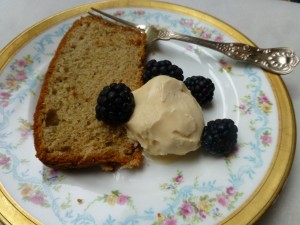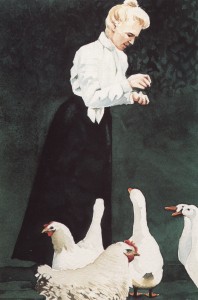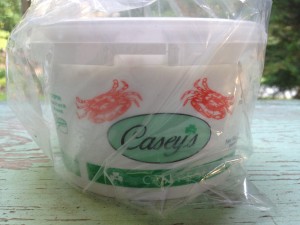
Photo by Allison Beuker.
Vintage cookbooks and especially community, church, and Junior League recipe collections offer a lens into the food culture of the time–what was fashionable, what was available, and what was deemed good enough for “company” or for at least putting forth for a fundraiser for your church or social group. One thing I love reading through are the recipes for punch and cocktails. I love that the recipes usually have the name of the contributor as part of the title: “Sue Emory’s Eggnog” for example. It makes me think: Who was Sue? Was her eggnog really good? Did she throw the best Christmas party? Did Bob the tee-totaller get sauced on her eggnog and end up wearing the lampshade on his head in 1952?

Photo by Allison Beuker.
The best old recipes have excellent ‘head notes’ (you know, those descriptions preceding the ingredients that tell you the why, what for, provenance, special notes or anecdotes about the recipe to follow.) Read the head note and if makes you want to try the recipe right then and there, then it’s a good one.

Doesn’t this make you thirsty?
Photo by Allison Beuker.
A little late for Derby Day, I know, but this recipe for a Mint Julep from “Queen Anne Goes to the Kitchen, Third Edition” produced by The Episcopal Women of St. Paul’s Parish of Centreville, Maryland is a gem. Produced for the tricentennial of the founding of St. Paul’s Parish (that’s 300 years ya’ll), this church cookbook has some of the most pithy and interesting head notes I’ve ever read and some of the best Old-School recipes for classic Chesapeake cooking.
So with no further introduction, I give you “Mint Julep” reproduced in its entirety.
MINT JULEP
This recipe is extracted from a letter of Colonel S.B. Buckner, Jr., U.S. Infantry, Ft. George G. Meade, MD, to Major General William D. Conner, West Point, NY, dated March 30, 1937.
cool, clear spring water (bottled)
lots of fresh mint
a good Kentucky bourbon
sugar bowl
row of silver goblets and spoons
ice
In a canvas bag pound twice as much ice as you think you will need. Make it fine as snow and keep it dry.
In each goblet put a heaping teaspoon of sugar, barely cover with spring water and slightly bruise one mint leaf into this mixture, leaving the spoon in the goblet. Pour bourbon to make about 1/4 full. Wipe goblet dry and embellish copiously with mint.
Then comes the important and delicate operation of frosting. By proper manipulation of the spoon, the ingredients are circulated and blended until the goblet is encrusted with frost.
Colonel Buckner ends: “Thus harmoniously blended by the deft touches of a skilled hand, you have a beverage eminently appropriate for honorable men and beautiful women.”
” When all is ready, assemble your guests on the porch or in the garden, where the drama of the juleps will rise heaven-ward and make the birds sing…Being overcome by thirst, I can write no further.”
–S.B. Buckner, Jr., Col., U.S. Infantry

Vintage sterling shot measures.
Photo by Allison Beuker.
Integral to the enjoyment of Mint Juleps, in addition to the fine technique instructions of Colonel Buckner (above), the fine company to drink them with, and the wrap-around porch, are the accoutrements that go with making them. These vintage sterling shot measures are engraved with ‘Little Shot’ (1 oz. marked on the bottom), ‘Just A Shot’ (1 1/2 oz on bottom) and ‘Big Shot’ (marked 2 ounces on bottom.)
The Colonel’s cocktail instructions just say to fill your silver goblet up 1/4 way with bourbon after your shaved ice and muddled mint are in. The amount of bourbon would depend on the size of your goblet (and here we photographed some genteel sterling punch cups). We can imagine the Southern porch parties gone awry as characters mix their own bourbon and ice ratios. In fact, I’m sure great Southern novels came out of that phenomenon.















